List of Hudson River School artists
The following is a list of the seventy-one painters in the Hudson River School, a mid-19th-century American art movement. The movement was led by a group of landscape painters whose aesthetic vision was influenced by romanticism. Some of these artists are also considered luminists, a related movement in mid-19th-century American painting that was characterized in the twentieth century. Their paintings depict the Hudson River Valley and the surrounding area, as well as the Catskill Mountains, Adirondack Mountains, and White Mountains of New Hampshire. Note that "school" in this sense refers to a group of people whose outlook, inspiration, output, or style demonstrates a common thread, rather than a learning institution.
List
[edit]Artists are listed alphabetically by surname.
| Artist Name | Portrait | Famous Work | Birth | Death | Description | Refs. |
|---|---|---|---|---|---|---|
| Charles Baker |  |
1839 | 1888 | American landscape painter of the Hudson River School. He painted idyllic landscape paintings of an early American wilderness and the scenic vistas of the White Mountains in New Hampshire. He exhibited at the National Academy from 1839 to 1873 and at the American Art-Union in 1847. He was deeply influenced by the dramatic work of Thomas Cole and painted in a romantic style clearly tied to Cole's sublime aesthetic. He was one of the founders of the Art League of New York. | ||
| William Bliss Baker | 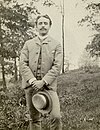
|
 |
27 November 1859 | 20 November 1886 | American artist who began painting just as the Hudson River School was winding down. He studied at the National Academy of Design under Bierstadt and de Haas, and maintained studios in Clifton Park, New York, and New York City, where he painted in oils and watercolors. He completed more than 130 paintings, including several works in black and white. Baker died at age 26 at his father's house at Hoosick Falls, New York. The New York Times said that his death "deprived America of one of its most promising artists." Fallen Monarchs (left) is considered his masterpiece. | [1] |
| John Dodgson Barrow | 24 November 1824 | 7 December 1906 | ||||
| Susie M. Barstow |  |
9 May 1836 | 12 June 1923 | Avid hiker and early member of the Appalachian Mountain Club, she is known for light-filled landscapes that exude serenity. | ||
| Julie Hart Beers |  |
1835 | 13 August 1913 | One of the few women of the Hudson River School to be commercially successful, she painted sweeping, well-balanced compositions with telling details. | ||
| Albert Fitch Bellows | 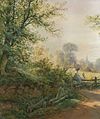 |
20 November 1829 | 24 November 1883 | |||
| Albert Bierstadt | 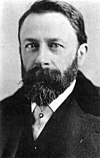
|
 |
7 January 1830 | 18 February 1902 | German-American painter best known for his large, detailed landscapes of the American West. In obtaining the subject matter for these works, Bierstadt joined several journeys of the Westward Expansion. Though not the first artist to record these sites, Bierstadt was the foremost painter of these scenes for the remainder of the 19th century. | [2] |
| DeWitt Clinton Boutelle |  |
6 April 1820 | 5 November 1884 | |||
| James Renwick Brevoort |  |
20 July 1832 | 15 December 1918 | |||
| Alfred Thompson Bricher | 
|
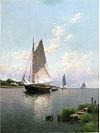 |
10 April 1837 | 30 September 1908 | American artist, one of the last painters in Hudson River School, known for his exploration of the effects of light and how it reflected, refracted, and absorbed on landscapes and seascapes. | |
| George Loring Brown | 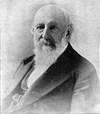
|
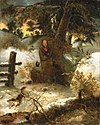 |
2 February 1814 | 25 June 1889 | ||
| William Mason Brown | 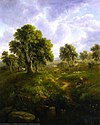 |
1828 | 6 September 1898 | |||
| Johann Hermann Carmiencke |  |
1810 | 15 June 1867 | |||
| John William Casilear |  |
25 June 1811 | 17 August 1893 | Engraver who was encouraged to take up painting by Asher Durand | ||
| Thomas Chambers |  |
1808 | 1869 | |||
| Charles H. Chapin |  |
1830 | 1889 | |||
| Frederic Edwin Church |  |
4 May 1826 | 7 April 1900 | Student of Thomas Cole, he became a central figure in the Hudson River School of American landscape painters. Church is perhaps best known for painting large panoramic landscapes, often depicting dramatic natural phenomena, with emphasis on light and a romantic respect for natural detail. In his later years, Church painted classical European and Middle Eastern cityscapes. He created many of his works at Olana. | [2] | |
| Thomas Cole | 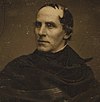
|
 |
1 February 1801 | 11 February 1848 | Commonly acknowledged as the founder of the Hudson River School, he painted scenes near his home in Catskill, New York | [2][3] |
| Samuel Colman |  |
4 March 1832 | 26 March 1920 | National academician whose landscapes show the influence of the Hudson River School, he is believed to have studied under Asher Durand. | ||
| Jasper Francis Cropsey | 
|
 |
18 February 1823 | 23 April 1900 | First-generation member of the Hudson River School, he painted autumn landscapes that startled viewers with their boldness and brilliance. As an artist, he believed landscapes were the highest art form and that nature was a direct manifestation of God. Cropsey was a founding member of the American Watercolor Society, and was one of few Hudson River School artists to paint in that medium. | |
| William Moore Davis | 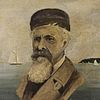
|
 |
22 May 1829 | 26 March 1920 | ||
| Lockwood de Forest | 
|
 |
8 June 1850 | 3 April 1932 | ||
| Victor DeGrailly |  |
25 October 1804 | 4 September 1887 | |||
| Thomas Doughty |  |
19 July 1793 | 22 July 1856 | First American artist to work exclusively as a landscapist and was successful both for his skill and the fact that Americans were turning their interest to landscape. | [4] | |
| Robert S. Duncanson | 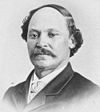
|
 |
1821 | 21 December 1872 | African American artist painting before and during the Civil War whose landscapes were influenced by the Hudson River School | |
| Asher Brown Durand | 
|
 |
21 August 1796 | 17 September 1886 | Engraver who took up landscape painting, he is particularly remembered for his detailed portrayals of trees, rocks, and foliage, especially with his masterpiece, Kindred Spirits. He also mentored and encouraged many other more junior artists. | [2] |
| Samuel P. Dyke |  |
1835 | 1870 | |||
| Alvan Fisher | 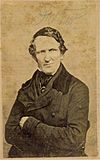
|
 |
9 August 1792 | 13 February 1863 | ||
| Hermann Fuechsel |  |
8 August 1833 | 30 September 1915 | |||
| William Charles Anthony Frerichs | 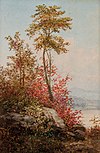 |
2 March 1829 | 16 March 1905 | |||
| Charles Henry Gifford | 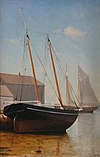 |
13 July 1839 | 20 January 1904 | |||
| Sanford Robinson Gifford | 
|
 |
10 July 1823 | 29 August 1880 | One of the leading members of the Hudson River School. Gifford's landscapes are known for their emphasis on light and soft atmospheric effects, and he is regarded as a practitioner of Luminism, an offshoot style of the Hudson River School. | |
| Régis François Gignoux | 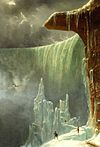 |
1816 | 1882 | |||
| Eliza Pratt Greatorex | 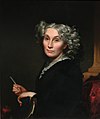
|
 |
25 December 1819 | 9 February 1897 | ||
| Daniel Charles Grose |  |
21 March 1832 | 24 February 1900 | English army officer who emigrated to the United States around 1867. He sketched and painted pastoral landscapes throughout the northeast, especially in Maine, Connecticut, and the Hudson River Valley. | ||
| James McDougal Hart | 
|
 |
10 May 1828 | 24 October 1901 | Scottish-born American landscape and cattle painter of the Hudson River School. His older brother, William Hart, was also a Hudson River School artist, and the two painted similar subjects. Sister Julie Hart Beers (Kempson) was also a landscape artist of this school. | |
| William Hart | 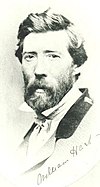
|
 |
31 March 1823 | 17 June 1894 | Scottish-born American landscape and cattle painter, and Hudson River School artist. His younger brother, James McDougal Hart, was also a Hudson River School artist, and the two painted similar subjects. He studied under Jules-Joseph Lefebvre. | |
| William Stanley Haseltine | 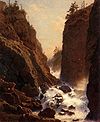 |
11 June 1835 | 3 February 1900 | American painter and draftsman who was associated with the Hudson River School and Luminism. By 1859 he was installed in the Tenth Street Studio Building in New York City, then a central point for American landscape painters; also in the building were Frederic Edwin Church, Albert Bierstadt, and Worthington Whittredge, the latter two having befriended Haseltine in Europe. | ||
| Robert Havell, Jr. |  |
25 November 1793 | 11 November 1878 | |||
| Martin Johnson Heade | 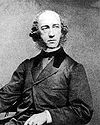
|
11 August 1819 | 4 September 1904 | Prolific artist who painted many different subjects including landscapes. There are mixed views as to whether Heade is part of the Hudson River School or was only partially influenced by it. Regardless, he was friends with many of the more prominent members, including Church. | ||
| Hermann Ottomar Herzog |  |
15 November 1831 | 6 February 1932 | German landscape painter who moved to Pennsylvania and painted subjects across the United States. He is considered a part of the Hudson River School, but typically painted a more realistic and less dramatic scene than Bierstadt or Church. | ||
| Thomas Hill | 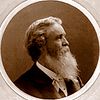
|
 |
11 September 1829 | 30 June 1908 | English born painter, he moved to the United States at age 15. He produced many fine paintings of the California landscape, in particular of the Yosemite Valley, as well as the White Mountains of New Hampshire. | |
| Ransome Gillett Holdridge | 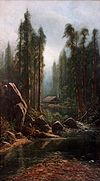 |
1836 | 1899 | |||
| George Inness | 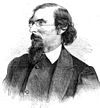
|
 |
1 May 1825 | 3 August 1894 | ||
| David Johnson |  |
10 May 1827 | 30 January 1908 | Johnson was born in New York City and studied for two years at the antique school of the National Academy of Design. He also studied briefly with Jasper Francis Cropsey. Along with John Frederick Kensett and John William Casilear, he was best known for the development of Luminism. | ||
| John Frederick Kensett | 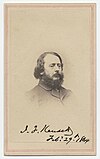
|
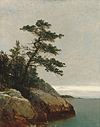 |
22 March 1816 | 14 December 1872 | Kensett is best known for his landscapes of upstate New York and New England and seascapes of coastal New Jersey, Long Island and New England. | |
| Charles Wilson Knapp |  |
17 March 1823 | 15 May 1900 | |||
| Edmund Darch Lewis |  |
17 October 1835 | 12 August 1910 | |||
| Homer Dodge Martin | 
|
 |
28 October 1836 | 12 February 1897 | ||
| George McCord | 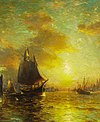 |
1 August 1848 | 6 April 1909 | |||
| Jervis McEntee | 
|
 |
14 July 1828 | 27 January 1891 | American painter of the Hudson River School. He is a somewhat lesser-known figure of the 19th-century American art world, but was the close friend and traveling companion of several of the important Hudson River School artists. | |
| Mary Blood Mellen |  |
1819 | 1886 | Mellen studied under Fitz Henry Lane and developed a luminist style for her landscapes and maritime subjects. | ||
| Louis Rémy Mignot |  |
3 February 1831 | 22 September 1870 | |||
| Charles Herbert Moore |  |
10 April 1840 | 15 February 1930 | Considered a minor member of the Hudson River School, Moore later began painting in the Pre-Raphaelite style. He later became the first art professor at Harvard University, and the first director of the university's Fogg Art Museum. Moore was one of few watercolor painters in the Hudson River School, and was an early member of the American Watercolor Society. | ||
| Thomas Moran | 
|
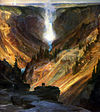 |
12 February 1837 | 25 August 1926 | Artist of the Hudson River School. Thomas Moran's vision of the Western landscape was critical to the creation of Yellowstone National Park. His pencil and watercolor field sketches and paintings captured the grandeur and documented the extraordinary terrain and natural features of the Yellowstone region. | |
| William Sidney Mount | 
|
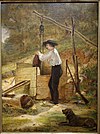 |
26 November 1807 | 19 November 1868 | ||
| Arthur Parton |  |
26 March 1842 | 7 March 1914 | |||
| Harriet Cany Peale | 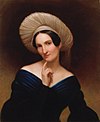
|
 |
1799 | 12 January 1869 | ||
| William Trost Richards | 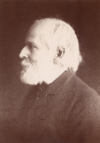
|
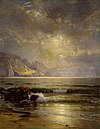 |
14 November 1833 | 8 November 1905 | ||
| Ferdinand Richardt | 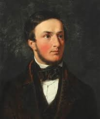
|
 |
10 April 1819 | 29 October 1895 | ||
| Thomas Prichard Rossiter | 
|
 |
20 September 1818 | 17 May 1871 | ||
| Francis Augustus Silva | 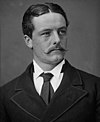
|
 |
4 October 1835 | 31 March 1886 | ||
| William Louis Sonntag Sr. | 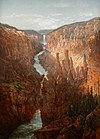 |
1822 | 1900 | |||
| James Augustus Suydam | 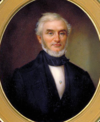
|
 |
27 March 1819 | 25 September 1865 | ||
| Jesse Talbot |  |
1 April 1805 | 29 January 1879 | Associate member of the National Academy of Design and a friend of the poet Walt Whitman. Talbot worked for the American Tract Society and other evangelical Christian organizations in New York City before becoming a professional artist, first exhibiting in the National Academy in 1838. His work was often favorably compared to that of Thomas Cole. The notebook in which Whitman first wrote down the ideas for Leaves of Grass is known as the “Talbot Wilson notebook” because Talbot's name and address (Wilson Street in Brooklyn, New York) are written on the inside front cover. | ||
| William Guy Wall |  |
1792 | 1864 | |||
| Mary Josephine Walters |  |
1837 | 1883 | |||
| Paul Weber |  |
19 January 1823 | 12 October 1916 | |||
| Robert Walter Weir | 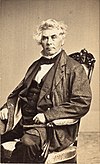
|
 |
18 June 1803 | 1 May 1889 | Elected to the National Academy of Design in 1829, Robert Weir was an American artist associated with the Hudson River School. He was an instructor at the United States Military Academy for forty-two years, 1832–1874. | |
| Worthington Whittredge | 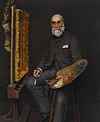
|
 |
22 May 1820 | 25 February 1910 | American artist of the Hudson River School. He was a highly regarded artist of his time, and was friends with several leading Hudson River School artists including Albert Bierstadt and Sanford Robinson Gifford. He traveled widely and excelled at landscape painting, many examples of which are now in major museums. He served as president of the National Academy of Design from 1874 to 1875. | |
| John Williamson |  |
1826 | 28 May 1885 | Scottish-American painter |
References
[edit]- ^ Jones, Agnes Halsey (1968). "Introduction—The Hudson River School". Hudson River School. Geneseo, New York, United States: W. F. Humphrey Press. pp. 1–9, 16–17.
- ^ a b c d Avery, Kevin J. (October 2004). "The Hudson River School". Metropolitan Museum of Art. Archived from the original on 2 March 2019. Retrieved 28 November 2018.
- ^ Hanc, John (23 October 2017). "'Scenes of Solitude' From Hudson River School Artists". The New York Times. Archived from the original on 29 November 2018. Retrieved 28 November 2018.
- ^ Blumberg, Naomi; et al. (20 July 2018). "Thomas Doughty". Encyclopedia Britannica. Archived from the original on 28 November 2018. Retrieved 27 November 2018.
